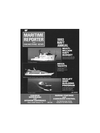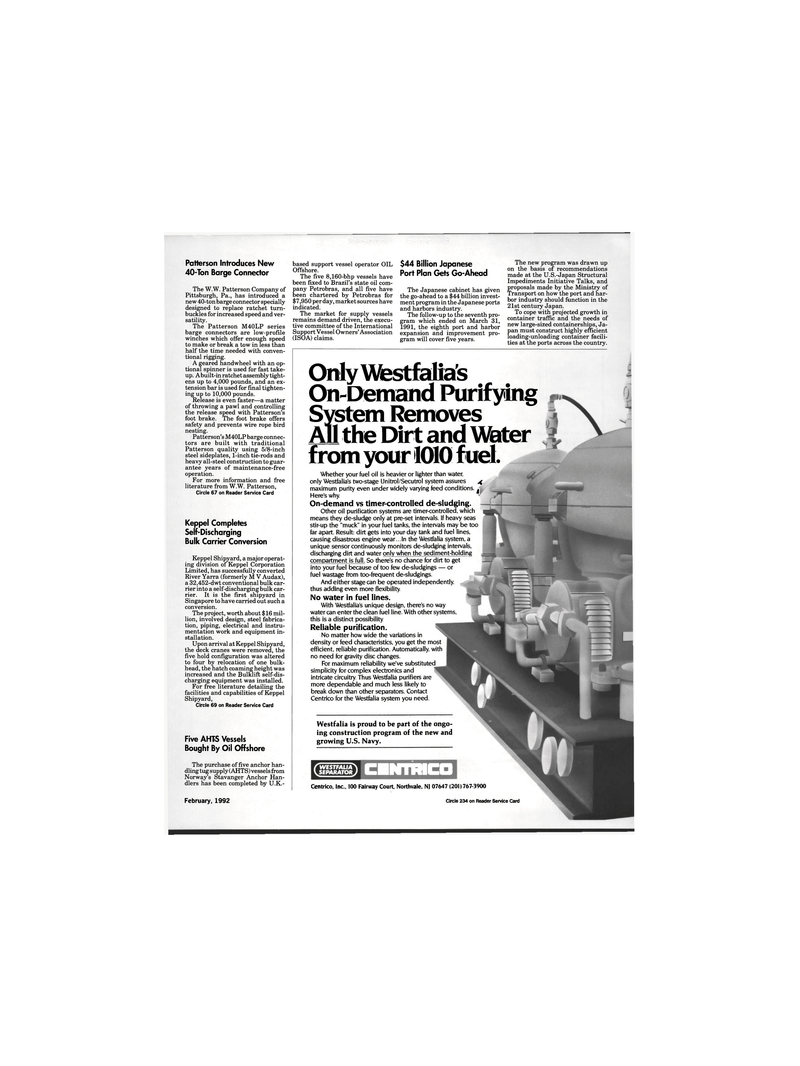
Page 83: of Maritime Reporter Magazine (February 1992)
Read this page in Pdf, Flash or Html5 edition of February 1992 Maritime Reporter Magazine
Patterson Introduces New 40-Ton Barge Connector
The W.W. Patterson Company of
Pittsburgh, Pa., has introduced a new 40-ton barge connector specially designed to replace ratchet turn- buckles for increased speed and ver- satility.
The Patterson M40LP series barge connectors are low-profile winches which offer enough speed to make or break a tow in less than half the time needed with conven- tional rigging.
A geared handwheel with an op- tional spinner is used for fast take- up. A built-in ratchet assembly tight- ens up to 4,000 pounds, and an ex- tension bar is used for final tighten- ing up to 10,000 pounds.
Release is even faster—a matter of throwing a pawl and controlling the release speed with Patterson's foot brake. The foot brake offers safety and prevents wire rope bird nesting.
Patterson's M40LP barge connec- tors are built with traditional
Patterson quality using 5/8-inch steel sideplates, 1-inch tie-rods and heavy all-steel construction to guar- antee years of maintenance-free operation.
For more information and free literature from W.W. Patterson,
Circle 67 on Reader Service Card based support vessel operator OIL
Offshore.
The five 8,160-bhp vessels have been fixed to Brazil's state oil com- pany Petrobras, and all five have been chartered by Petrobras for $7,950 per day, market sources have indicated.
The market for supply vessels remains demand driven, the execu- tive committee of the International
Support Vessel Owners'Association (ISOA) claims. $44 Billion Japanese
Port Plan Gets Go-Ahead
The Japanese cabinet has given the go-ahead to a $44 billion invest- ment program in the Japanese ports and harbors industry.
The follow-up to the seventh pro- gram which ended on March 31, 1991, the eighth port and harbor expansion and improvement pro- gram will cover five years.
The new program was drawn up on the basis of recommendations made at the U.S.-Japan Structural
Impediments Initiative Talks, and proposals made by the Ministry of
Transport on how the port and har- bor industry should function in the 21st century Japan.
To cope with projected growth in container traffic and the needs of new large-sized containerships, Ja- pan must construct highly efficient loading-unloading container facili- ties at the ports across the country.
Keppel Completes
Self-Discharging
Bulk Carrier Conversion
Keppel Shipyard, a major operat- ing division of Keppel Corporation
Limited, has successfully converted
River Yarra (formerly M V Audax), a 32,452-dwt conventional bulk car- rier into a self-discharging bulk car- rier. It is the first shipyard in
Singapore to have carried out such a conversion.
The project, worth about $16 mil- lion, involved design, steel fabrica- tion, piping, electrical and instru- mentation work and equipment in- stallation.
Upon arrival at Keppel Shipyard, the deck cranes were removed, the five hold configuration was altered to four by relocation of one bulk- head, the hatch coaming height was increased and the Bulklift self-dis- charging equipment was installed.
For free literature detailing the facilities and capabilities of Keppel
Shipyard,
Circle 69 on Reader Service Card
Five AHTS Vessels
Bought By Oil Offshore
The purchase of five anchor han- dling tug supply (AHTS) vessels from
Norway's Stavanger Anchor Han- dlers has been completed by U.K.-
February, 1992
CENTRICO
Westfalia is proud to be part of the ongo- ing construction program of the new and growing U.S. Navy.
Centrico, Inc., 100 Fairway Court, Northvale, NJ 07647 (201)767-3900
Circle 234 on Reader Service Card
Only Westfalia's
On-Demand Purifying
System Removes
All the Dirt and Water from your 1010 fuel.
Whether your fuel oil is heavier or lighter than water, only Westfalia's two-stage Unitrol/Secutrol system assures ^ maximum purity even under widely varying feed conditions. ^
Here's why.
On-demand vs timer-controlled de-sludging.
Other oil purification systems are timer-controlled, which means they de-sludge only at pre-set intervals. If heavy seas stir-up the "muck" in your fuel tanks, the intervals may be too far apart. Result: dirt gets into your day tank and fuel lines, causing disastrous engine wear...In the Westfalia system, a unique sensor continuously monitors de-sludging intervals, discharging dirt and water only when the sediment-holding compartment is full. So there's no chance for dirt to get into your fuel because of too few de-sludgings — or fuel wastage from too-frequent de-sludgings.
And either stage can be operated independently, thus adding even more flexibility.
No water in fuel lines.
With Westfalia's unique design, there's no way water can enter the clean fuel line. With other systems, this is a distinct possibility.
Reliable purification.
No matter how wide the variations in density or feed characteristics, you get the most efficient, reliable purification. Automatically, with no need for gravity disc changes.
For maximum reliability we've substituted simplicity for complex electronics and intricate circuitry. Thus Westfalia purifiers are more dependable and much less likely to break down than other separators. Contact
Centrico for the Westfalia system you need.

 82
82

 84
84
